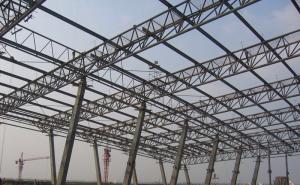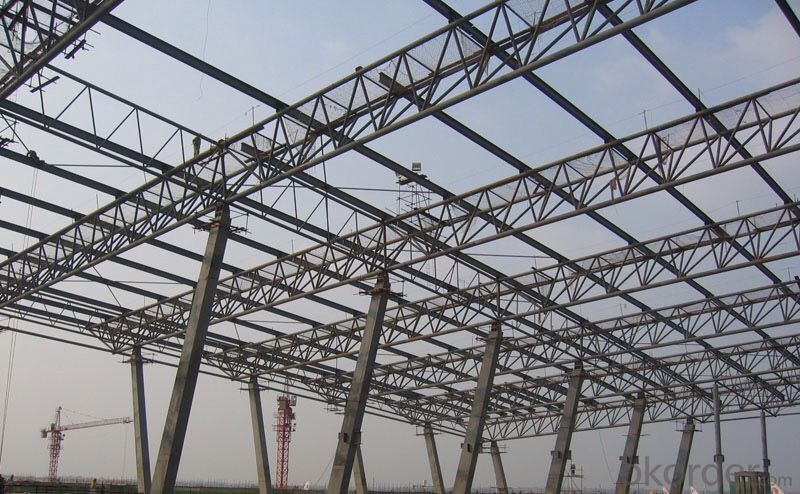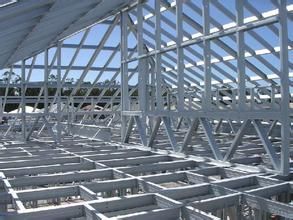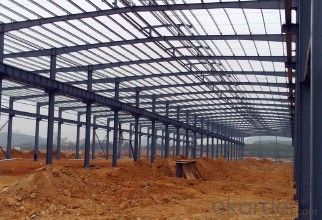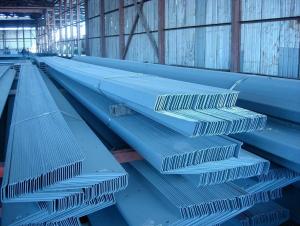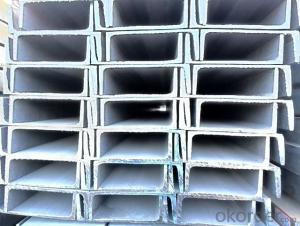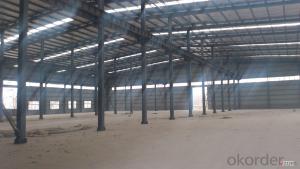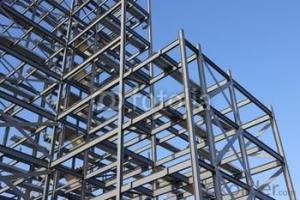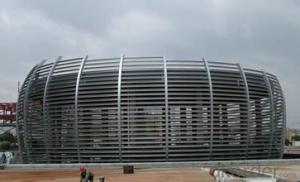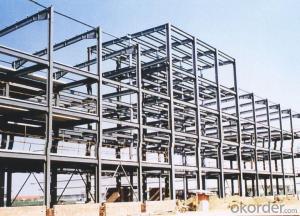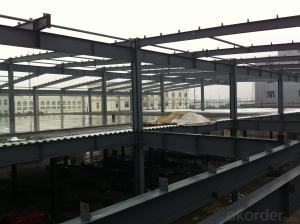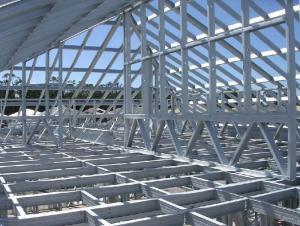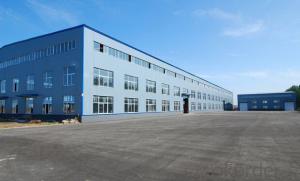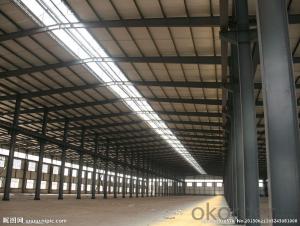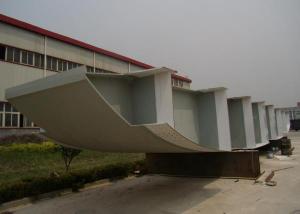Steel Structure Workshop Warehouse With High Quality
- Loading Port:
- China Main Port
- Payment Terms:
- TT or LC
- Min Order Qty:
- -
- Supply Capability:
- -
OKorder Service Pledge
OKorder Financial Service
You Might Also Like
OKorder is offering Steel Structure Workshop Warehouse With High Qualityat great prices with worldwide shipping. Our supplier is a world-class manufacturer of steel, with our products utilized the world over. OKorder annually supplies products to European, North American and Asian markets. We provide quotations within 24 hours of receiving an inquiry and guarantee competitive prices.
Product Applications:
Steel Structure Workshop Warehouse With High Quality are ideal for structural applications and are widely used in the construction of buildings and bridges, and the manufacturing, petrochemical, and transportation industries.
Product Advantages:
Steel Structure Workshop Warehouse With High Qualityare durable, strong, and resist corrosion.
Main Product Features:
· Premium quality
· Prompt delivery & seaworthy packing (30 days after receiving deposit)
· Corrosion resistance
· Professional Service
· Competitive pricing
Product Specifications:
Project: Jinan west railway station
Position: The Beijing-Shanghai high speed railway (Jinan)
Steel dosage: 5000MTs
Structure type: Box, tube, bending and twisting, transverse connection
1. GB standard material
2. High Structural safety and reliability
3. The production can reach GB/JIS/ISO/ASME standard
Packaging & Delivery of steel structure
1. According to the project design and the component size, usually the main component parts are nude packing and shipped by bulk vessel. And the small parts are packed in box or suitable packages and shipped by containers.
2. This will be communicated and negotiated with buyer according to the design.
Engineering Design Software of steel structure
Tekla Structure \ AUTO CAD \ PKPM software etc
⊙Complex spatial structure project detailed design
⊙Construct 3D-model and structure analysis. ensure the accuracy of the workshop drawings
⊙Steel structure detail ,project management, automatic Shop Drawing, BOM table automatic generation system.
⊙Control the whole structure design process, we can obtain higher efficiency and better results
Technical support of steel structure
Production Flow of steel structure/steel frame
Material preparation—cutting—fitting up—welding—component correction—rust removal—paint coating—packing—to storage and transportation (each process has the relevant inspection)
FAQ:
Q1: Why buy Materials & Equipment from OKorder.com?
A1: All products offered byOKorder.com are carefully selected from China's most reliable manufacturing enterprises. Through its ISO certifications, OKorder.com adheres to the highest standards and a commitment to supply chain safety and customer satisfaction.
Q2: How do we guarantee the quality of our products?
A2: We have established an advanced quality management system which conducts strict quality tests at every step, from raw materials to the final product. At the same time, we provide extensive follow-up service assurances as required.
Q3: Can stainless steel rust?
A3: Stainless does not "rust" as you think of regular steel rusting with a red oxide on the surface that flakes off. If you see red rust it is probably due to some iron particles that have contaminated the surface of the stainless steel and it is these iron particles that are rusting. Look at the source of the rusting and see if you can remove it from the surface.
Images:
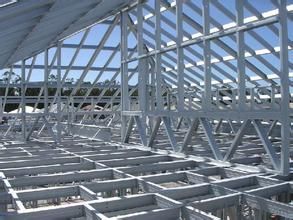
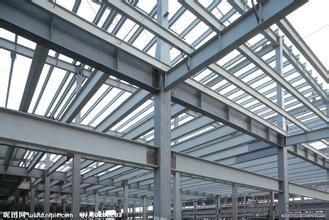
- Q: Can steel structures be designed to be resistant to corrosion from saltwater?
- Yes, steel structures can be designed to be resistant to corrosion from saltwater. Specialized coatings such as galvanization or corrosion-resistant paint can be applied to steel surfaces to protect them from the corrosive effects of saltwater. Additionally, stainless steel or other alloy steels with high levels of chromium or nickel can be used, as they have inherent resistance to corrosion in saltwater environments. Proper maintenance and regular inspections are also important to ensure the long-term durability and corrosion resistance of steel structures in saltwater conditions.
- Q: What are the considerations for steel structure design in earthquake-prone areas?
- When designing steel structures in earthquake-prone areas, there are several important considerations that need to be taken into account. These considerations are aimed at ensuring the safety and stability of the structure during seismic events. 1. Seismic Design Codes: The first consideration is to adhere to the seismic design codes and regulations specific to the region. These codes provide guidelines for the design, construction, and maintenance of structures in earthquake-prone areas. 2. Structural Analysis: It is crucial to perform a thorough structural analysis to determine the expected seismic forces and their effects on the steel structure. This analysis involves assessing the building's response to ground motion, evaluating the strength and deformation capacity of the steel elements, and considering the interaction between various components. 3. Ductility and Redundancy: Steel structures in earthquake-prone areas should be designed with high ductility and redundancy. Ductility refers to the ability of the structure to deform without losing its load-carrying capacity. Redundancy ensures that the structure can redistribute loads and resist failure even if certain elements are damaged. 4. Moment-Resisting Frames: Moment-resisting frames are commonly used in seismic design to provide resistance against lateral forces. These frames consist of beams and columns connected by rigid or semi-rigid connections, allowing them to transfer forces and moments effectively. 5. Base Isolation and Damping: Base isolation techniques involve separating the structure from the ground using flexible bearings or isolators. This helps to reduce the transmission of seismic energy to the building. Damping devices such as viscoelastic dampers or tuned mass dampers can also be incorporated to dissipate energy during earthquakes. 6. Strengthening Techniques: Existing steel structures in earthquake-prone areas may require strengthening to meet the seismic design requirements. Techniques such as adding bracing systems, steel jackets, or external post-tensioning can be employed to improve the structure's resistance to earthquakes. 7. Soil-Structure Interaction: Considering the interaction between the steel structure and the underlying soil is crucial. The characteristics of the soil, such as its stiffness and damping properties, can significantly affect the seismic response of the structure. Soil-structure interaction analysis should be conducted to ensure the design accounts for these effects. 8. Quality Control and Inspections: Regular quality control checks and inspections during construction are essential to ensure that the steel structure is being built according to the design specifications. Special attention should be given to welding, connections, and material quality to ensure the structure's integrity. By considering these aspects, engineers can design steel structures that can withstand seismic forces and minimize damage, ensuring the safety of occupants and preserving the structural integrity of the building in earthquake-prone areas.
- Q: What are the design considerations for steel structures in water or wastewater treatment plants?
- Some key design considerations for steel structures in water or wastewater treatment plants include corrosion resistance, durability, and structural stability. Since these structures are constantly exposed to water and various chemicals, selecting the appropriate type of steel with high corrosion resistance is crucial. Additionally, the design should ensure that the structure can withstand the harsh operating conditions over an extended period of time without significant maintenance or repairs. Lastly, structural stability is essential to ensure the safety and reliability of the facility, especially considering the dynamic loads and vibrations that may be present in water or wastewater treatment processes.
- Q: How are steel structures designed for different environmental conditions?
- Steel structures are designed for different environmental conditions by considering factors such as wind loads, snow loads, seismic activity, and corrosion. Engineers use specific design codes and standards that provide guidelines for calculating the appropriate design loads and selecting the appropriate steel members and connections to ensure the structure's stability and durability. Additionally, protective coatings and treatments can be applied to the steel to prevent corrosion in harsh environments. Overall, the design process involves a thorough analysis of the environmental conditions to ensure the steel structure can withstand and perform well under different conditions.
- Q: What are the common design considerations for steel structures in exhibition centers?
- Some common design considerations for steel structures in exhibition centers include the need for large open spaces to accommodate various exhibits and displays, the ability to support heavy loads such as hanging artwork or large sculptures, the incorporation of natural lighting and ventilation systems for a comfortable environment, and the flexibility to easily reconfigure the space for different events and exhibitions. Additionally, considerations for fire safety, durability, and sustainability are also important factors in the design process.
- Q: How are steel structures used in the construction of fast food chains?
- Steel structures are commonly used in the construction of fast food chains due to their strength, durability, and efficiency. Steel allows for large open spaces, allowing for flexible and versatile layouts for dining areas, kitchens, and drive-thru lanes. Additionally, steel structures are quick to assemble, reducing construction time and costs. They also provide a safe and sturdy framework that can withstand heavy loads, making them ideal for supporting the weight of equipment, signage, and other elements required in fast food chains.
- Q: In the steel structure of steel purlin 160*60*20*2.5 is what mean
- The horizontal component roof length distribution, located in the main rafters, support secondary rafters. The ancient houses used to stir up the rafters, roof bars made of, is one of the main components of the house, also called the boat (or sub truss northern dialect).
- Q: What are the design considerations for steel power plants?
- Designing steel power plants involves several key considerations to ensure optimal performance, safety, and efficiency. Here are some important design considerations for steel power plants: 1. Structural Integrity: The design should prioritize the structural integrity of the power plant, as it needs to withstand various mechanical and environmental stresses. Steel, being a strong and durable material, is commonly used to provide the necessary strength and stability. 2. Load-Bearing Capacity: Steel power plants must be designed to withstand the weight and load of heavy machinery, equipment, and turbines. The design should incorporate appropriate load-bearing structures to distribute the weight evenly and prevent any structural failures or deformations. 3. Safety Measures: Safety is a paramount consideration in power plant design. Steel power plants should have robust fire protection systems, emergency exits, and safety equipment. Additionally, the layout should facilitate safe movement of personnel and provide clear evacuation routes in case of emergencies. 4. Environmental Impact: Power plants have a significant impact on the environment, particularly in terms of emissions and waste generation. The design should incorporate measures to minimize harmful emissions, such as the installation of efficient pollution control systems and proper waste disposal mechanisms. 5. Energy Efficiency: Designing power plants with energy efficiency in mind is crucial for reducing operational costs and minimizing environmental impact. The layout should optimize the flow of energy, reduce heat loss, and incorporate efficient cooling and heating systems to maximize overall energy efficiency. 6. Maintenance and Accessibility: Easy access to equipment and machinery is essential for maintenance and repair activities. The design should include spacious walkways, platforms, and sufficient clearance for equipment removal and replacement. 7. Noise and Vibration Control: Power plants generate significant noise and vibrations, which can be detrimental to nearby communities and the overall working environment. Proper design considerations should be taken to minimize noise and vibration levels through the use of sound insulation materials, vibration dampeners, and isolation techniques. 8. Scalability and Future Expansion: Power plants are long-term investments, and their design should allow for future expansion and scalability. This includes considering factors like available land, accessibility to resources, and the ability to incorporate new technologies or equipment as required. 9. Integration with Grid Infrastructure: Designing power plants that seamlessly integrate with existing grid infrastructure is essential for efficient power distribution. Proper consideration should be given to connecting power plants to the grid, ensuring compatibility, and minimizing transmission losses. 10. Regulatory Compliance: Steel power plant design must adhere to relevant safety and environmental regulations set by local and international authorities. Compliance with these regulations is critical to ensure the plant's operations are legally and ethically sound. By considering these design considerations, engineers and designers can create steel power plants that are safe, efficient, and environmentally friendly, meeting the energy demands while minimizing their impact on the surroundings.
- Q: What is the maximum span of steel beams in a structure?
- The maximum span of steel beams in a structure can vary depending on several factors such as the type and grade of steel used, the load requirements, and the desired level of deflection. However, in general, steel beams can have spans ranging from a few feet to several hundred feet, making them highly versatile for various construction projects.
- Q: How do steel structures contribute to the overall architectural expression of a building?
- Steel structures contribute to the overall architectural expression of a building by providing a strong and durable framework that allows for larger and more intricate designs. The use of steel allows for greater flexibility in architectural design, as it can support wide spans and open floor plans. Additionally, steel structures can be shaped and formed into various aesthetic configurations, giving architects more creative freedom in their designs. The sleek and modern appearance of steel also adds a contemporary and industrial element to the building's overall look and feel.
Send your message to us
Steel Structure Workshop Warehouse With High Quality
- Loading Port:
- China Main Port
- Payment Terms:
- TT or LC
- Min Order Qty:
- -
- Supply Capability:
- -
OKorder Service Pledge
OKorder Financial Service
Similar products
Hot products
Hot Searches
Related keywords
